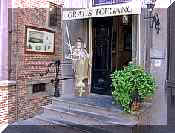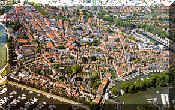Hoorn. (20 km)
In a visit in Hoorn, one senses it immediately: Hoorn maintains its past, arranged the view however also on the 21st century.

Blooming
trade city.
Hoorn
received 1357 the city rights and developed itself quickly to an
important harbor city. In the so named golden age, the united
Ostindienkompanie left became itself among other things also here down
and Hoorn a blooming trade city.
Hundreds
from ships Hoorn went over the world oceans and turned pass load with
trade ware home.
Spice
as well as pepper, nutmeg, carnations became with high profit sold.
The
trade and the ship trip made the enterprising citizens of Hoorn far over
the country boundary out famously.
Storms
heavy the discovery trip Willem Cornelisz Schouten trotzte and umrundete
in the year 1616 the most southern point of South America.

Fisherman
village.
Wealth,
power and prosperity went in the 18th century to end.
Hoorn
became a verschlafenes fisherman village at the Zuiderzee.
After
the French predominance, a time broke on, in which the city turned away
itself gradually of the sea, and to a market center of the agriculture
zone west frieze country developed.
Market
sales people and store proprietor specialized themselves on the trade
with dairy products and agricultural seeds.
With
the building of railroad lines and streets end the 19th century.
The
city became century a well attainable center in the network of the
cities and villages in Noord-Holland.

Gardening
cultivation.
After
the second world war again a growth period inserted.
Middle
in a blooming gardening cultivation, a center city with a mixed economy
emerged.
In
the Sechzigerjahren, Hoorn became of the government the relief zone for
the overfull Randstad, that concentration room in the west of the
Netherlands explains.
Harmonious
entire.
Hoorn
passed through an enormous growth process in the last half century and
counts in the mean time more than 66.000 inhabitant.
Also
today and in the next years be yet constructed.
Not
only at the outskirts, new residential zones emerge, also directly in
the inner cities and on that adjacent new dwellings are constructed.
The
Apartments round around the Karperkuil prove that through new
construction in a historic zone a surprising and harmonious entire can
emerge.
Hoorn
offers not only its characteristic inhabitants, but rather a complete
and change empire offer at bildings-, healthness-, cultivation and
leisure time arrangements to the total region. Student out of the
villages and cities of west frieze country, but also of outside of the
region visit a continuing in Hoorn or berufsbildende waiter training.
The
sand mountain institute, that arrangement for postgraduale courses of
the Amsterdammer Rietveldakademie, is in the art and cultivation city
Hoorn exact at the correct place.
Art
and cultivati
The
jahrhundertealten monuments form a magnificent wing for the contemporary
art and cultivation.
Hoorn
has 365 monuments to show and is therewith after Amsterdam and Haarlem
the third monument city of Noord-Holland.
To
the most famous monuments, building, that stand at both oldest places of
the city, the Roode Steen and the Kerkplein belong.
In
the scales erected by Hendrick de Keyser 1609 at the Roode Steen to
start of the last century, cheese gewogen became.
Vis-á-vis
the gable decorated, colorful with lions and city crest of the from the
year 1632 coming Statencollege, the former seat de regional
administration is located.
The
building harbors today the Westfriesische museum in which the
cultivation heir of the golden age be issued.

Brown
fleet.
The
city makes available more and more Baudenkmäler for displays and
organizations.
That
in the year 1563 erected St. Jansgasthuis at the Kerkplein was original
a hospital.
Later
became here with butter acted and baptized one it therefore around in
Boterhal (butter hall). Now it be used as a display room for works from
artists the entire country.
The
Pakhuis in the street Onder de Boompjes, that served in the times of the
united Ostindienkompanie as a spice storage, is today an important
platform for the amateur theater. The monuments of Hoorn are confessed
far over the country boundary out.
In
the Japanese Nagasaki Holland Village, 16 monument remote control
switches building became out of Hoorn nachgebaut, among other things the
Hoofdtoren (head tower) from the year 1632, one of the most
characteristic monuments of the city.
The
Verteidigungsbollwerk offers a lovely outlook over the harbor with the
brown fleet.
There
also the going monuments, the historic Dutch fisherman boats are located
Schouw and Botter.
International
Flair.
Also
the tourism creates work places and became an important receipt source.
The
landscape and the kulturhistorische heir are the trumps of the city.
Annually
come later about a half million day visitor Hoorn.
In
the summer, the harbor and the lake Markermeer dress numerous water
athletes and recovery that which is sought.
The
harbor developed itself to a water sport center with international Flair
and be supposed to be completed the number of the couch places in the
future further.
The
environment of Hoorn offers many bicycles and to footpath that pass
diagonally through the far Polderlandschaft.
They
lead the visitor over little Binnendeiche and at old villages past or
over the Omringdijk, that dike, that protected once the country against
the sea.
In
Beemster Polder, that was explained by the Unesco to the world
cultivation heir, one finds yet the summer houses of the Hoorner sales
people out of the 17th century.
But
in spite of the entire scenic and kulturhistorischen splendor it yet in
the end the inhabitants of Hoorn itself, who lend the city its cultural
and dynamic radiation and who provide for renewal, are.

Back
